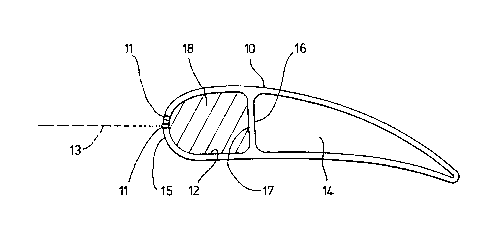Some of the information on this Web page has been provided by external sources. The Government of Canada is not responsible for the accuracy, reliability or currency of the information supplied by external sources. Users wishing to rely upon this information should consult directly with the source of the information. Content provided by external sources is not subject to official languages, privacy and accessibility requirements.
Any discrepancies in the text and image of the Claims and Abstract are due to differing posting times. Text of the Claims and Abstract are posted:
| (12) Patent: | (11) CA 2041356 |
|---|---|
| (54) English Title: | LASER DRILLING |
| (54) French Title: | PERCAGE AU LASER |
| Status: | Expired and beyond the Period of Reversal |
| (51) International Patent Classification (IPC): |
|
|---|---|
| (72) Inventors : |
|
| (73) Owners : |
|
| (71) Applicants : |
|
| (74) Agent: | GOWLING WLG (CANADA) LLP |
| (74) Associate agent: | |
| (45) Issued: | 1997-11-25 |
| (22) Filed Date: | 1991-04-26 |
| (41) Open to Public Inspection: | 1991-10-27 |
| Examination requested: | 1994-05-26 |
| Availability of licence: | N/A |
| Dedicated to the Public: | N/A |
| (25) Language of filing: | English |
| Patent Cooperation Treaty (PCT): | No |
|---|
| (30) Application Priority Data: | ||||||
|---|---|---|---|---|---|---|
|
A material is described for preventing the
occurrence of damage to the backwall of a cavity within
a component during laser drilling of holes into said
component. The material comprises an acrylic resin
having polytetrafluoroethylene dispersed within it and
is polymerized before laser drilling. A method for
preventing such backwall damage occurring during laser
drilling using this material is also described and the
method comprises the steps of at least partially
filling the cavity in the component with a material
comprising an acrylic resin monomer and
polytetrafluoroethylene (PTFE), the monomer
incorporating a suitable initiator to promote
polymerisation, and allowing said material to
polymerise in situ in the cavity prior to laser
drilling.
L'invention est un matériau servant à empêcher l'endommagement de la paroi arrière d'une cavité à l'intérieur d'un composant durant le perçage de trous dans ce composant au moyen d'un laser. Ce matériau contient une résine acrylique dans laquelle un polytétrafluoroéthylène est en dispersion, et qui est polymérisée avant le perçage au laser. Une méthode utilisant ce matériau pour empêcher l'endommagement de la paroi arrière durant les opérations de perçage au laser est également divulguée. Dans cette méthode, la cavité qui est à l'intérieur du composant est au moins partiellement remplie avec un matériau contenant un monomère de résine acrylique et un polytétrafluoroéthylène, ce monomère contenant un agent d'amorçage approprié pour faciliter la polymérisation; le perçage au laser se fait pour permettre la polymérisation de ce matériau in situ dans la cavité.
Note: Claims are shown in the official language in which they were submitted.
Note: Descriptions are shown in the official language in which they were submitted.

2024-08-01:As part of the Next Generation Patents (NGP) transition, the Canadian Patents Database (CPD) now contains a more detailed Event History, which replicates the Event Log of our new back-office solution.
Please note that "Inactive:" events refers to events no longer in use in our new back-office solution.
For a clearer understanding of the status of the application/patent presented on this page, the site Disclaimer , as well as the definitions for Patent , Event History , Maintenance Fee and Payment History should be consulted.
| Description | Date |
|---|---|
| Time Limit for Reversal Expired | 2001-04-26 |
| Letter Sent | 2000-04-26 |
| Grant by Issuance | 1997-11-25 |
| Inactive: Application prosecuted on TS as of Log entry date | 1997-09-22 |
| Inactive: Status info is complete as of Log entry date | 1997-09-22 |
| Pre-grant | 1997-06-03 |
| Inactive: Adhoc Request Documented | 1997-04-28 |
| Deemed Abandoned - Failure to Respond to Maintenance Fee Notice | 1997-04-28 |
| Notice of Allowance is Issued | 1996-12-10 |
| Request for Examination Requirements Determined Compliant | 1994-05-26 |
| All Requirements for Examination Determined Compliant | 1994-05-26 |
| Application Published (Open to Public Inspection) | 1991-10-27 |
| Abandonment Date | Reason | Reinstatement Date |
|---|---|---|
| 1997-04-28 |
| Fee Type | Anniversary Year | Due Date | Paid Date |
|---|---|---|---|
| Registration of a document | 1997-05-21 | ||
| Final fee - standard | 1997-06-03 | ||
| MF (patent, 7th anniv.) - standard | 1998-04-27 | 1998-03-16 | |
| MF (patent, 8th anniv.) - standard | 1999-04-26 | 1999-03-17 |
Note: Records showing the ownership history in alphabetical order.
| Current Owners on Record |
|---|
| AETC LIMITED |
| Past Owners on Record |
|---|
| GLYNDWYR J. DAVIES |
| JONATHON D. PHILBY |